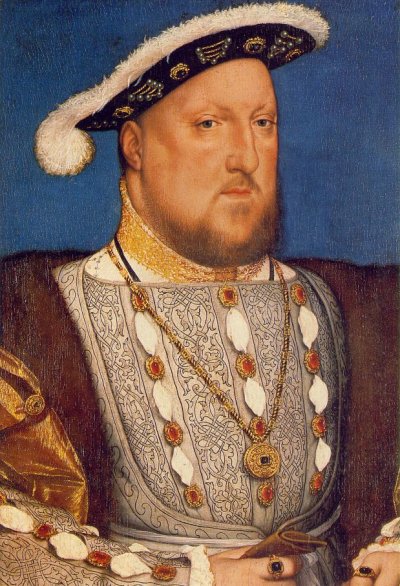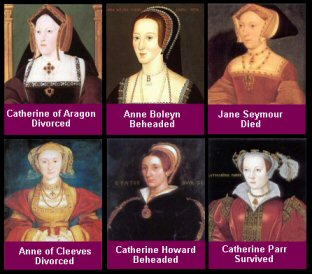Class 10. The early Tudors. The Reformation in Europe and in England. The Counter-Reformation
The early Tudors
King Henry VII (b. 1457, ruled from 1485 to 1509) - the founder of the dynasty. A representative of the House of Lancaster who married Elizabeth of York, thus ending the dynastic struggle in England.
King Henry VIII (b. 1491, ruled from 1509 to 1547) - son of Henry VII. Famous for numerous marriages and the split with the Catholic Church, which paved the way to the Protestant Reformation in England.

Six wives of Henry VIII

Source:
http://www.britroyals.com/tudor.asp?id=henry8
Married:(1) Catherine of Aragon, 1509: Mary (1516)
Married (2): Anne Boleyn, 1533: Elizabeth (1533)
Married (3): Jane Seymour, 1536: Edward (1537)
Married (4): Anne of Cleves, 1540
Married (5): Catherine Howard, 1540
Married (6): Catherine Parr, 1543
The Reformation in Europe and England
1517 - Martin Luther publishes the 95 theses agains the Catholic Church. The beginning of the Reformation in Europe.
N.B.! Be ready to explain the main difference between Protestantism and Catholicism. If you haven't got it from the lectures, try to google.
1527 - Reformation in Sweden (and Finland).
1527 - Henry VIII seeks divorce from Catherin of Aragon from the Pope, but his appeal is refused.
1529 - Henry VIII starts to cut ties with the Church of Rome, gradually coming to the establishment of an independent English Church.
1531 - Reformation in Switzerland (incomplete).
1533 - Henry VIII divorces from Catherin of Aragon, marries Anne Boleyn and is excommunicated by the Pope. A final split with the Roman Catholic Church.
1534 - Act of Supremacy establishes Henry VIII (and all ensuing English monarchs with the exception of Queen Mary) as head of the Church of England.
N.B.! During the Henry VIII's reign, the Church of England actually (in structure and ritual) remained Catholic, although the ties with the Pope had been cut. So, it wasn't technically a Reformation, but rather a pre-Reformation.
1534 - Jesuit Order established as a part of the Catholic Counter-Reformation.
1536-40 - Dissolution of Monasteries in England.
1537 - Reformation in Denmark-Norway.
1547 - Edward VI accedes to the throne at the age of nine. His regents, staunch Protestants, completed the transformation of the Church of England into a Protestant body.
1553 - Edward VI dies and his elder sister Mary is crowned Queen. Restoration of the Catholic Church in England (Counter-Reformation).
1554 - Executions of Protestants begin, for which Mary receives her nickname "Bloody".
1558 - Mary dies without an heir, and Elizabeth becomes Queen of England. Under Queen Elizabeth I, the Anglican Church will once again transform into a Puritan body, but will keep some of the features of the Catholic Church.
1560 - Reformation in Scotland
1572 - St. Bartholomew's Day Massacre in France
1618-1648 - The Thirty-Years' War. WIth its end, the large-scale religious conflicts in Europe that lasted for one hundred and thirty years were mostly over.